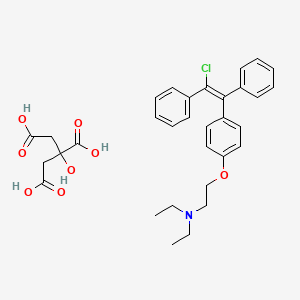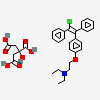Enclomiphene citrate
- Enclomiphene citrate
- 7599-79-3
- trans-Clomiphene citrate
- trans-Clomifene citrate
- CLOMIPHENE CITRATE
- Create:2006-04-14
- Modify:2025-01-18

- (E)-2-(p-(2-Chloro-1,2-Diphenylvinyl)phenoxy)triethylamine
- (E)-2-(p-(2-Chloro-1,2-Diphenylvinyl)phenoxy)triethylamine Citrate
- Androxal
- Citrate, Enclomiphene
- Citrate, trans-Clomiphene
- En-Clomiphene
- Enclomifene
- Enclomiphen
- Enclomiphene
- Enclomiphene Citrate
- trans Clomiphene
- trans Clomiphene Citrate
- trans-Clomiphene
- trans-Clomiphene Citrate
- Enclomiphene citrate
- 7599-79-3
- trans-Clomiphene citrate
- trans-Clomifene citrate
- CLOMIPHENE CITRATE
- Clomiphene (citrate)
- Enclomid
- Enclomiphene citrate [USAN]
- Clomiphene b citrate
- 50-41-9
- (E)-Clomiphene citrate
- Clomid
- 7599-79-3 (citrate)
- J303A6U9Y6
- Enclomiphene citrate (USAN)
- 2-[4-[(E)-2-chloro-1,2-diphenylethenyl]phenoxy]-N,N-diethylethanamine;2-hydroxypropane-1,2,3-tricarboxylic acid
- (E)-2-(4-(2-chloro-1,2-diphenylvinyl)phenoxy)-N,N-diethylethan-1-amine 2-hydroxypropane-1,2,3-tricarboxylate
- SR-01000736753
- UNII-J303A6U9Y6
- Serophene (TN)
- Prestwick_757
- Clomid (TN)
- Enclomiphene citrate?
- EN Clomiphene Citrate
- Clomiphene citrate (USP)
- Clomifene citrate (JP18)
- MLS002548893
- SCHEMBL220459
- CHEMBL1200667
- ARD169639CI
- Clomiphene (citrate) (Standard)
- HY-B0463R
- DTXSID80226887
- PYTMYKVIJXPNBD-BTKVJIOYSA-N
- HMS1569O15
- HMS2096O15
- HMS2230I16
- HMS3713O15
- 1ST169639CI
- EX-A2939
- HY-B0463
- ENCLOMIPHENE CITRATE [WHO-DD]
- AKOS027323718
- Triethylamine, 2-(p-(2-chloro-1,2-diphenylvinyl)phenoxy)-, citrate, (E)-
- CCG-220397
- 2-(4-(2-Chloro-1,2-diphenylvinyl)phenoxy)-N,N-diethylethanamine 2-hydroxypropane-1,2,3-tricarboxylate
- 2-[4-[(E)-2-chloro-1,2-diphenylethenyl]phenoxy]-N,N-diethylethanamine; 2-hydroxypropane-1,2,3-tricarboxylic acid
- AS-13733
- DA-52890
- Clomiphene citrate salt, analytical standard
- D00962
- D10876
- G12156
- A828113
- Q-200877
- SR-01000736753-4
- SR-01000736753-8
- Q27281081
- Clomifene citrate, European Pharmacopoeia (EP) Reference Standard
- Clomiphene citrate, United States Pharmacopeia (USP) Reference Standard
- Clomifene citrate for performance test, European Pharmacopoeia (EP) Reference Standard
- 2-[4-[(E)-2-chloranyl-1,2-diphenyl-ethenyl]phenoxy]-N,N-diethyl-ethanamine; 2-oxidanylpropane-1,2,3-tricarboxylic acid
- ETHANAMINE, 2-(4-((1E)-2-CHLORO-1,2-DIPHENYLETHENYL)PHENOXY)-N,N-DIETHYL-, 2-HYDROXY-1,2,3-PROPANETRICARBOXYLATE (1:1)
- Clomiphene Citrate (annotation moved to)
- Ethanamine, 2-(4-(2-chloro-1,2-diphenylethenyl)phenoxy)-N,N-diethyl-, (E)-, 2-hydroxy-1,2,3-propanetricarboxylate (1:1) (annotation moved to)

H360 (10.2%): May damage fertility or the unborn child [Danger Reproductive toxicity]
H361 (87.8%): Suspected of damaging fertility or the unborn child [Warning Reproductive toxicity]
P203, P280, P318, P405, and P501
(The corresponding statement to each P-code can be found at the GHS Classification page.)
Aggregated GHS information provided per 49 reports by companies from 9 notifications to the ECHA C&L Inventory. Each notification may be associated with multiple companies.
Information may vary between notifications depending on impurities, additives, and other factors. The percentage value in parenthesis indicates the notified classification ratio from companies that provide hazard codes. Only hazard codes with percentage values above 10% are shown.
Repr. 1A (10.2%)
Repr. 2 (87.8%)
IMAP assessments - Ethanamine, 2-[4-(2-chloro-1,2-diphenylethenyl)phenoxy]-N,N-diethyl-, 2-hydroxy-1,2,3-propanetricarboxylate (1:1): Human health tier I assessment
IMAP assessments - Ethanamine, 2-[4-(2-chloro-1,2-diphenylethenyl)phenoxy]-N,N-diethyl-, 2-hydroxy-1,2,3-propanetricarboxylate (1:1): Environment tier I assessment
- Australian Industrial Chemicals Introduction Scheme (AICIS)Ethanamine, 2-[4-(2-chloro-1,2-diphenylethenyl)phenoxy]-N,N-diethyl-, 2-hydroxy-1,2,3-propanetricarboxylate (1:1)https://services.industrialchemicals.gov.au/search-assessments/
- CAS Common ChemistryLICENSEThe data from CAS Common Chemistry is provided under a CC-BY-NC 4.0 license, unless otherwise stated.https://creativecommons.org/licenses/by-nc/4.0/Enclomiphene citratehttps://commonchemistry.cas.org/detail?cas_rn=7599-79-3
- ChemIDplusEnclomiphene citrate [USAN]https://pubchem.ncbi.nlm.nih.gov/substance/?source=chemidplus&sourceid=0007599793ChemIDplus Chemical Information Classificationhttps://pubchem.ncbi.nlm.nih.gov/source/ChemIDplus
- EPA DSSToxEnclomiphene citratehttps://comptox.epa.gov/dashboard/DTXSID80226887CompTox Chemicals Dashboard Chemical Listshttps://comptox.epa.gov/dashboard/chemical-lists/
- European Chemicals Agency (ECHA)LICENSEUse of the information, documents and data from the ECHA website is subject to the terms and conditions of this Legal Notice, and subject to other binding limitations provided for under applicable law, the information, documents and data made available on the ECHA website may be reproduced, distributed and/or used, totally or in part, for non-commercial purposes provided that ECHA is acknowledged as the source: "Source: European Chemicals Agency, http://echa.europa.eu/". Such acknowledgement must be included in each copy of the material. ECHA permits and encourages organisations and individuals to create links to the ECHA website under the following cumulative conditions: Links can only be made to webpages that provide a link to the Legal Notice page.https://echa.europa.eu/web/guest/legal-noticeClomifen dihydrogen citratehttps://echa.europa.eu/substance-information/-/substanceinfo/100.000.033(E)-2-[4-(2-Chloro-1,2-diphenylvinyl)-phenoxy]triethylaminehttps://echa.europa.eu/substance-information/-/substanceinfo/100.217.764Clomifen dihydrogen citrate (EC: 200-035-3)https://echa.europa.eu/information-on-chemicals/cl-inventory-database/-/discli/details/33312(E)-2-[4-(2-Chloro-1,2-diphenylvinyl)-phenoxy]triethylamine (EC: 690-639-7)https://echa.europa.eu/information-on-chemicals/cl-inventory-database/-/discli/details/223147
- FDA Global Substance Registration System (GSRS)LICENSEUnless otherwise noted, the contents of the FDA website (www.fda.gov), both text and graphics, are not copyrighted. They are in the public domain and may be republished, reprinted and otherwise used freely by anyone without the need to obtain permission from FDA. Credit to the U.S. Food and Drug Administration as the source is appreciated but not required.https://www.fda.gov/about-fda/about-website/website-policies#linkingENCLOMIPHENE CITRATEhttps://gsrs.ncats.nih.gov/ginas/app/beta/substances/J303A6U9Y6
- California Office of Environmental Health Hazard Assessment (OEHHA)Clomiphene Citratehttps://oehha.ca.gov/proposition-65/chemicals/clomiphene-citrate
- NCI Thesaurus (NCIt)LICENSEUnless otherwise indicated, all text within NCI products is free of copyright and may be reused without our permission. Credit the National Cancer Institute as the source.https://www.cancer.gov/policies/copyright-reuseNCI Thesaurushttps://ncit.nci.nih.gov
- Open TargetsLICENSEDatasets generated by the Open Targets Platform are freely available for download.https://platform-docs.opentargets.org/licenceENCLOMIPHENE CITRATEhttps://platform.opentargets.org/drug/CHEMBL1200667
- ChEMBLLICENSEAccess to the web interface of ChEMBL is made under the EBI's Terms of Use (http://www.ebi.ac.uk/Information/termsofuse.html). The ChEMBL data is made available on a Creative Commons Attribution-Share Alike 3.0 Unported License (http://creativecommons.org/licenses/by-sa/3.0/).http://www.ebi.ac.uk/Information/termsofuse.html
- ClinicalTrials.govLICENSEThe ClinicalTrials.gov data carry an international copyright outside the United States and its Territories or Possessions. Some ClinicalTrials.gov data may be subject to the copyright of third parties; you should consult these entities for any additional terms of use.https://clinicaltrials.gov/ct2/about-site/terms-conditions#Use
- Drug Gene Interaction database (DGIdb)LICENSEThe data used in DGIdb is all open access and where possible made available as raw data dumps in the downloads section.http://www.dgidb.org/downloadsENCLOMIPHENE CITRATEhttps://www.dgidb.org/drugs/ncit:C61745
- Drugs@FDALICENSEUnless otherwise noted, the contents of the FDA website (www.fda.gov), both text and graphics, are not copyrighted. They are in the public domain and may be republished, reprinted and otherwise used freely by anyone without the need to obtain permission from FDA. Credit to the U.S. Food and Drug Administration as the source is appreciated but not required.https://www.fda.gov/about-fda/about-website/website-policies#linking
- EU Clinical Trials Register
- KEGGLICENSEAcademic users may freely use the KEGG website. Non-academic use of KEGG generally requires a commercial licensehttps://www.kegg.jp/kegg/legal.htmlTherapeutic category of drugs in Japanhttp://www.genome.jp/kegg-bin/get_htext?br08301.kegUSP drug classificationhttp://www.genome.jp/kegg-bin/get_htext?br08302.kegAnatomical Therapeutic Chemical (ATC) classificationhttp://www.genome.jp/kegg-bin/get_htext?br08303.kegTarget-based classification of drugshttp://www.genome.jp/kegg-bin/get_htext?br08310.kegDrugs listed in the Japanese Pharmacopoeiahttp://www.genome.jp/kegg-bin/get_htext?br08311.keg
- NIPH Clinical Trials Search of Japan
- Wikidataenclomiphene citratehttps://www.wikidata.org/wiki/Q27281081
- Medical Subject Headings (MeSH)LICENSEWorks produced by the U.S. government are not subject to copyright protection in the United States. Any such works found on National Library of Medicine (NLM) Web sites may be freely used or reproduced without permission in the U.S.https://www.nlm.nih.gov/copyright.htmlEnclomiphenehttps://www.ncbi.nlm.nih.gov/mesh/68064695Estrogen Antagonistshttps://www.ncbi.nlm.nih.gov/mesh/68004965Selective Estrogen Receptor Modulatorshttps://www.ncbi.nlm.nih.gov/mesh/68020845Fertility Agents, Femalehttps://www.ncbi.nlm.nih.gov/mesh/68005300
- PubChem
- GHS Classification (UNECE)GHS Classification Treehttp://www.unece.org/trans/danger/publi/ghs/ghs_welcome_e.html
- International Agency for Research on Cancer (IARC)LICENSEMaterials made available by IARC/WHO enjoy copyright protection under the Berne Convention for the Protection of Literature and Artistic Works, under other international conventions, and under national laws on copyright and neighbouring rights. IARC exercises copyright over its Materials to make sure that they are used in accordance with the Agency's principles. All rights are reserved.https://publications.iarc.fr/Terms-Of-UseIARC Classificationhttps://www.iarc.fr/
- MolGenieMolGenie Organic Chemistry Ontologyhttps://github.com/MolGenie/ontology/
- NCBI

 CID 1548953 (Enclomiphene)
CID 1548953 (Enclomiphene) CID 311 (Citric Acid)
CID 311 (Citric Acid)